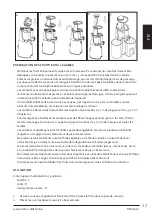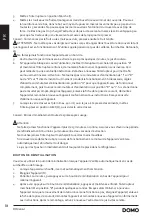
26
DO9248J
DE
7
juice,
jam strainer is used for making ketchup only
while frozen dish strainer is used for
making frozen dish. Select the appropriate strainer based on your demand.
3. Assemble the jar lid on the jar correctly. Firstly, put the jar lid downwards and then
make the symbol “ ” on the jar lid align with the symbol “
” on the jar and then rotate
the jar lid clockwise until the symbol “ ” on the jar lid aligns with the symbol “ ”on the
jar (See Fig.4).
After it, press the fastener inwards to lock the jar lid well in position. The
jar lid shall be assembled well in position properly otherwise the appliance will not operate.
Finally, put the food pusher into the jar lid.
Fig.3
Fig.4
6
7
juice,
jam strainer is used for making ketchup only
while frozen dish strainer is used for
making frozen dish. Select the appropriate strainer based on your demand.
3. Assemble the jar lid on the jar correctly. Firstly, put the jar lid downwards and then
make the symbol “ ” on the jar lid align with the symbol “
” on the jar and then rotate
the jar lid clockwise until the symbol “ ” on the jar lid aligns with the symbol “ ”on the
jar (See Fig.4).
After it, press the fastener inwards to lock the jar lid well in position. The
jar lid shall be assembled well in position properly otherwise the appliance will not operate.
Finally, put the food pusher into the jar lid.
Fig.3
Fig.4
7
juice,
jam strainer is used for making ketchup only
while frozen dish strainer is used for
making frozen dish. Select the appropriate strainer based on your demand.
3. Assemble the jar lid on the jar correctly. Firstly, put the jar lid downwards and then
make the symbol “ ” on the jar lid align with the symbol “
” on the jar and then rotate
the jar lid clockwise until the symbol “ ” on the jar lid aligns with the symbol “ ”on the
jar (See Fig.4).
After it, press the fastener inwards to lock the jar lid well in position. The
jar lid shall be assembled well in position properly otherwise the appliance will not operate.
Finally, put the food pusher into the jar lid.
Fig.3
Fig.4
7
7
juice,
jam strainer is used for making ketchup only
while frozen dish strainer is used for
making frozen dish. Select the appropriate strainer based on your demand.
3. Assemble the jar lid on the jar correctly. Firstly, put the jar lid downwards and then
make the symbol “ ” on the jar lid align with the symbol “
” on the jar and then rotate
the jar lid clockwise until the symbol “ ” on the jar lid aligns with the symbol “ ”on the
jar (See Fig.4).
After it, press the fastener inwards to lock the jar lid well in position. The
jar lid shall be assembled well in position properly otherwise the appliance will not operate.
Finally, put the food pusher into the jar lid.
Fig.3
Fig.4
8
8
4. Place your juice container below the juice outlet and residue
container below the residue outlet (see Fig.5). Until now, the
Juicer is ready for operating.
Note:
When need to remove the whole appliance, please grasp
the motor unit instead of the jar lid to remove it to avoid
accident.
USING YOUR JUICER
1. Before attaching the power cord into the outlet, make sure the
power switch is in the “
O
” position, the power switch has three settings: “
I
” indicates
“ON”, press the power switch to “
I
” position to activate the motor and start making juice;
“
O
” indicates “OFF” position, press the power switch to “
O
” position to turn off the
machine; “
R
” means reverse rotation, which is only used when something is stuck and you
need to unclog.
2. Make sure the juice container and the residue container are placed in position.
3. Cut fruits and vegetables into smaller pieces. For example, the carrots shall be cut into
thin slices with size of 15mm×15mm before being put into the machine.
NOTE:
A) Please remove any hard seeds before juicing.
B) It is forbidden to process coconuts, sugarcane or similar hard foodstuffs, since this
may damage the motor.
C
)
)
)
)
It is not recommended to process hard fruit or vegetable rich in fiber and starch.
D) The peel and pits should be removed from oranges, lemons, grapefruits and melons.
4. Drop the prepared fruits or vegetables into the jar lid at an even speed and then let the
Fig.5
9
VORBEREITUNG DER FRÜCHTE UND/ODER GEMÜSE
· Putzen Sie das Obst und das Gemüse und schneiden Sie es in Stücke. Karotten sollten zum Beispiel in
dünne Scheiben von etwa 15 mm x 15 mm geschnitten werden, bevor sie in den Slow Juicer eingeführt
werden.
· Entfernen Sie harte Kerne oder Samen vor dem Entsaften, sonst kann die Press-Schnecke beschädigt
werden. Die Kerne von Pfirsich, Nektarine, Pflaume, Mango und Aprikose sollten nicht in den
Fülltrichter eingeführt werden, um Störungen oder potentielle Gefahren zu vermeiden.
· Lebensmittel mit dicker oder harter Schale schälen, bevor sie zur Verarbeitung in den Slow Juicer
eingeführt werden. Von Orangen, Zitronen, Grapefruits und Melonen müssen vor dem Entsaften
Schale und Samen entfernt werden.
· Es ist verboten, Kokosnüsse mit ihrer Schale, komplette Zuckerrohrstiele oder ähnliche harte
Lebensmittel zu verarbeiten, da dies den Motor beschädigen könnte.
· Lebensmittel mit Hartfaser in Stücke mit 30-50 mm Länge und 15-20 mm Dicke schneiden.
· Stiele von Blattgemüsen und Lebensmitteln mit langer und harter Faser (z.B. Sellerie, wilder Sellerie
und Kohl etc.) in 30-50 mm lange Stücke schneiden und die Blätter einrollen.
· Gefrorene Lebensmittel können nach dem Auftauen verwendet werden. Niemals gefrorene
Lebensmittel oder Eis in den Slow Juicer einführen.
· Niemals Lebensmittel mit hohem Gehalt an Pflanzenöl oder tierischem Öl mit diesem Slow Juicer
verarbeiten, um den Verschleiß und Beschädigung der Press-Schnecke zu vermeiden.
· Niemals Zuckerrohr, Kokosfruchtfleisch, Kudzuwurzel oder Getreide (z.B. Bohnen, Reis etc.) in den
Slow Juicer einführen, bevor diese in Wasser eingeweicht wurden.
· Geben Sie nie zu viele Lebensmittel auf einmal in das Gerät. Deshalb müssen Lebensmittel mit wenig
Feuchtigkeit und harten Fasern in Scheiben geschnitten werden, bevor sie in den Fülltrichter gegeben
werden.
· Es ist nicht empfehlenswert, harte Früchte oder Gemüse zu verarbeiten, die reich an Ballaststoffen
und Stärke sind.














































